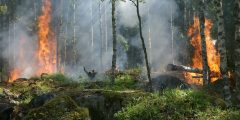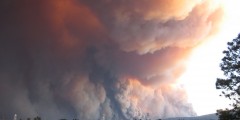Climate change and language change
July 1, 2022
For over ten years I have now been thinking and writing about extreme weather events, especially floods and fires, and how they are verbally and visually represented in the media and beyond. Over that decade the issue of extreme weather has become increasingly topical and people no longer hesitate to discuss this topic in the …
The IPCC report: Impacts, adaptation and vulnerabilities
March 4, 2022
When I think about the latest IPCC report, which came out on 28 February, these sentences come to my (German) mind: Eintritt streng verboten! Eintritt strengstens verboten!! Eintritt allerstrengstens verboten!!! (Entry strictly forbidden. Entry very strictly forbidden. Entry extremely strictly forbidden.) These words are written on warning signs that adorn three doors in the classic …
The concept of net zero hangs in the balance
November 12, 2021
‘Net zero’ has been in the air for a while and I let it waft over me without taking much notice. However, a few days ago I read Ken Rice’s thoughts on this matter on his And Then There’s Physics blog. He argues against a “recurring narrative that the concept of net-zero is flawed”, saying …
IPCC reports, climate change and language work
September 6, 2021
This blog post is not about climate change communication. It is about what I call the ‘language work’ carried out by scientists when writing the various IPCC reports. Introduction On 9 August 2021 the first part of the Sixth Assessment Report of the Intergovernmental Panel on Climate Change, namely the Contribution of Working Group 1 …
When climate change hits home: A personal story
July 18, 2021
This month, Alice Bell has published an important book entitled Our Biggest Experiment: A History of the Climate Crisis. In it, she takes us “back to climate change science’s earliest steps in the eighteenth and nineteenth centuries, through the point when concern started to rise in the 1950s and right up to today, where the …
Chanting to the choir: The dialogical failure of antithetical climate change blogs
April 20, 2020
This is a guest post by Jennifer Metcalfe on a paper she just published. The article explored the potential for people commenting underneath two very different, even antithetical, blogs dealing with climate science, to chat about and engage with climate science. *** My paper, Chanting to the choir: the dialogical failure of antithetical climate change …









